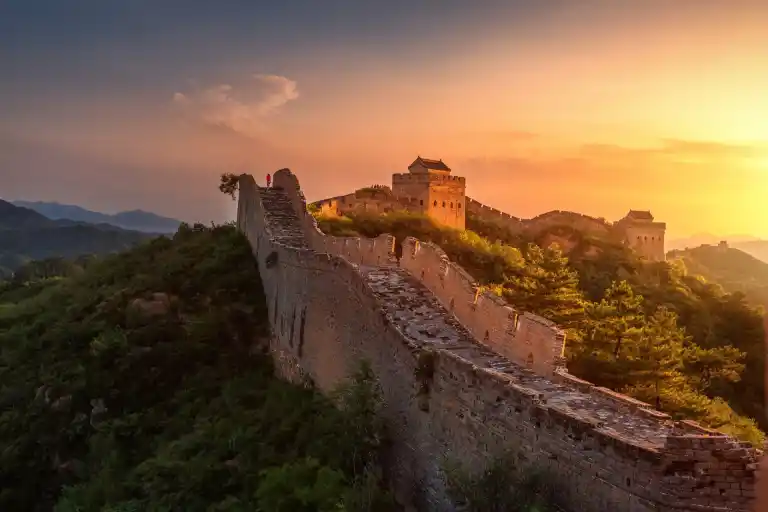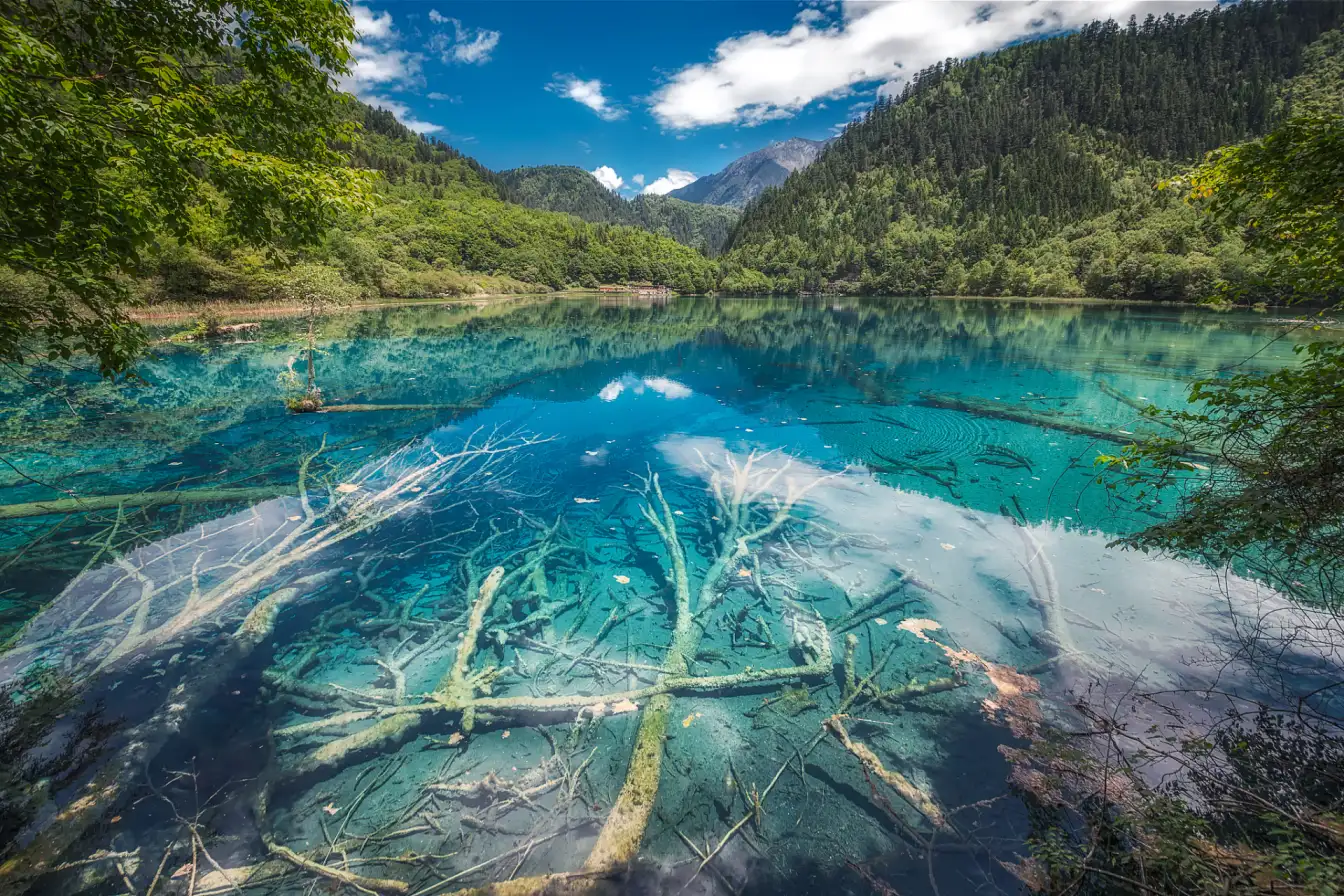
Explore the Majestic Jiuzhaigou Valley on Your China Adventure
1. Location and Overview 🗺️
Location: Jiuzhaigou Valley (九寨沟) is situated in the Aba Tibetan and Qiang Autonomous Prefecture (阿坝藏族羌族自治州) of Sichuan Province (四川省), China. It is renowned for its stunning natural scenery and colorful lakes.
Overview: Jiuzhaigou Valley is a UNESCO World Heritage Site and a designated UNESCO Biosphere Reserve. The valley is characterized by its pristine alpine lakes, waterfalls, and lush forests. It covers an area of approximately 720 square kilometers (280 square miles) and is home to diverse flora and fauna.
2. Unique Features 🏞️
- Multicolored Lakes: Jiuzhaigou is known for its numerous lakes, each with its own distinct coloration, ranging from turquoise to emerald green and azure blue.
- Waterfalls: The valley is adorned with numerous waterfalls, including the iconic Pearl Shoal Waterfall (珍珠滩瀑布) and Nuorilang Waterfall (诺日朗瀑布).
- Primeval Forests: Dense forests of fir, spruce, and pine trees cover much of the valley, providing habitat for wildlife such as pandas, golden monkeys, and various bird species.
- Ethnic Culture: Jiuzhaigou is home to Tibetan and Qiang ethnic minority groups, and visitors can experience their unique customs, architecture, and cuisine.
- Seasonal Changes: The valley undergoes dramatic transformations throughout the year, with each season offering its own distinct beauty.
3. Seasonal Changes 🍂❄️🌷☀️
- Spring (March-May): Blooming flowers, mild temperatures, and fewer crowds make spring an ideal time to visit Jiuzhaigou.
- Summer (June-August): Peak tourist season with warm temperatures and lush vegetation. However, expect larger crowds and occasional rain showers.
- Autumn (September-November): Stunning foliage colors, particularly in October, attract visitors seeking picturesque landscapes.
- Winter (December-February): The valley transforms into a winter wonderland with snow-covered landscapes. While fewer tourists visit during this time, some areas may be inaccessible due to snow.
4. Best Time to Visit ⏰
The best time to visit Jiuzhaigou Valley is during the shoulder seasons of spring (March-May) and autumn (September-November) when the weather is pleasant, and the scenery is at its most vibrant.
5. Travel Tips ✈️
- Advance Booking: Reserve tickets and accommodations in advance, especially during peak season, to avoid disappointment.
- Altitude Adjustment: Jiuzhaigou's high altitude (2,000 to 4,500 meters) may cause altitude sickness in some visitors. Take it easy, stay hydrated, and avoid strenuous activities upon arrival.
- Pack Essentials: Bring sturdy walking shoes, warm clothing (even in summer), sunscreen, sunglasses, and a reusable water bottle.
- Respect Local Customs: Jiuzhaigou is a Tibetan-influenced area, so be respectful of local customs and traditions, such as not disturbing prayer flags or touching religious artifacts.
- Environmental Protection: Help preserve the pristine environment by not littering, staying on designated trails, and following park regulations.
6. Cultural Significance 🏯
Jiuzhaigou Valley holds cultural significance for the Tibetan and Qiang ethnic minorities, who consider it a sacred place. Visitors can learn about their rich traditions, including Tibetan Buddhism, traditional dances, and handicrafts.
7. Tourist Attractions 🚶
- Five Flower Lake (五花海): Known for its stunning turquoise waters and colorful underwater flora.
- Long Lake (长海): The largest and deepest lake in Jiuzhaigou, offering breathtaking reflections of surrounding mountains.
- Mirror Lake (镜海): Reflects the surrounding landscape like a mirror, creating stunning photo opportunities.
- Zharu Valley (扎如沟): A pristine area of the valley known for its dense forests, waterfalls, and tranquility.
- Tibetan Villages: Explore traditional Tibetan villages such as Shuzheng Village (树正寨) and Zechawa Village (则查洼寨), where you can experience local culture and cuisine.
8. Nearby Attractions 🏞️
- Huanglong Scenic Area (黄龙风景区): Known for its colorful pools, limestone formations, and diverse wildlife.
- Ruoergai Grassland (若尔盖大草原): Vast grasslands with stunning natural scenery, located to the north of Jiuzhaigou.
9. How to Get There 🚗
- By Air: Fly to Chengdu Shuangliu International Airport (成都双流国际机场), then take a domestic flight to Jiuzhai Huanglong Airport (九寨黄龙机场).
- By Bus: Buses are available from Chengdu Chadianzi Bus Station (成都茶店子客运站) to Jiuzhaigou, with a travel time of approximately 8-10 hours.
- By Car: Private car hire or self-driving from Chengdu to Jiuzhaigou is also an option, but be prepared for a long journey of around 8-10 hours.
10. Practical Information 💼
- Ticket Price: Admission to Jiuzhaigou Valley is priced at approximately 220-330 RMB (35-50 USD) per person, depending on the season.
- Opening Hours: The park is open daily from 7:00 AM to 6:00 PM during peak season (April to November) and 8:00 AM to 5:30 PM during the offseason (December to March).
- Accommodation: There are various accommodation options available within the valley, including hotels, guesthouses, and Tibetan-style lodges.
11. Local Cuisine 🍜
- Tibetan Butter Tea (酥油茶): A traditional Tibetan drink made with tea leaves, yak butter, salt, and water.
- Yak Meat Hotpot (牦牛火锅): A hearty and warming dish featuring thinly sliced yak meat cooked in a flavorful broth with vegetables and spices.
- Tibetan Momos (饺子): Dumplings filled with meat or vegetables and served with a spicy dipping sauce.
12. Precautions to Take ⚠️
- Altitude Sickness: Be aware of the potential for altitude sickness and take precautions such as drinking plenty of water, avoiding alcohol, and resting if necessary.
- Weather Changes: Pack clothing for variable weather conditions, including warm layers, rain gear, and sun protection.
- Safety on Trails: Stick to designated paths and trails, as wandering off can be dangerous, especially near cliffs and waterfalls.
- Respect Wildlife: Do not feed or approach wild animals, as they may become aggressive or cause harm.
13. Conclusion 🌄
Jiuzhaigou Valley is a breathtaking destination that offers a mesmerizing blend of natural beauty, cultural heritage, and outdoor adventure. Whether you're captivated by the vivid hues of its multicolored lakes, enchanted by the cascading waterfalls, or intrigued by the rich Tibetan and Qiang culture, Jiuzhaigou promises an unforgettable experience.
From exploring pristine alpine landscapes to immersing yourself in local customs and cuisine, every moment spent in Jiuzhaigou is filled with wonder and discovery. As you venture through this UNESCO World Heritage Site, remember to tread lightly, respect the environment and local traditions, and savor every magical moment amidst the splendor of Jiuzhaigou Valley.



















Comments
Leave a reply